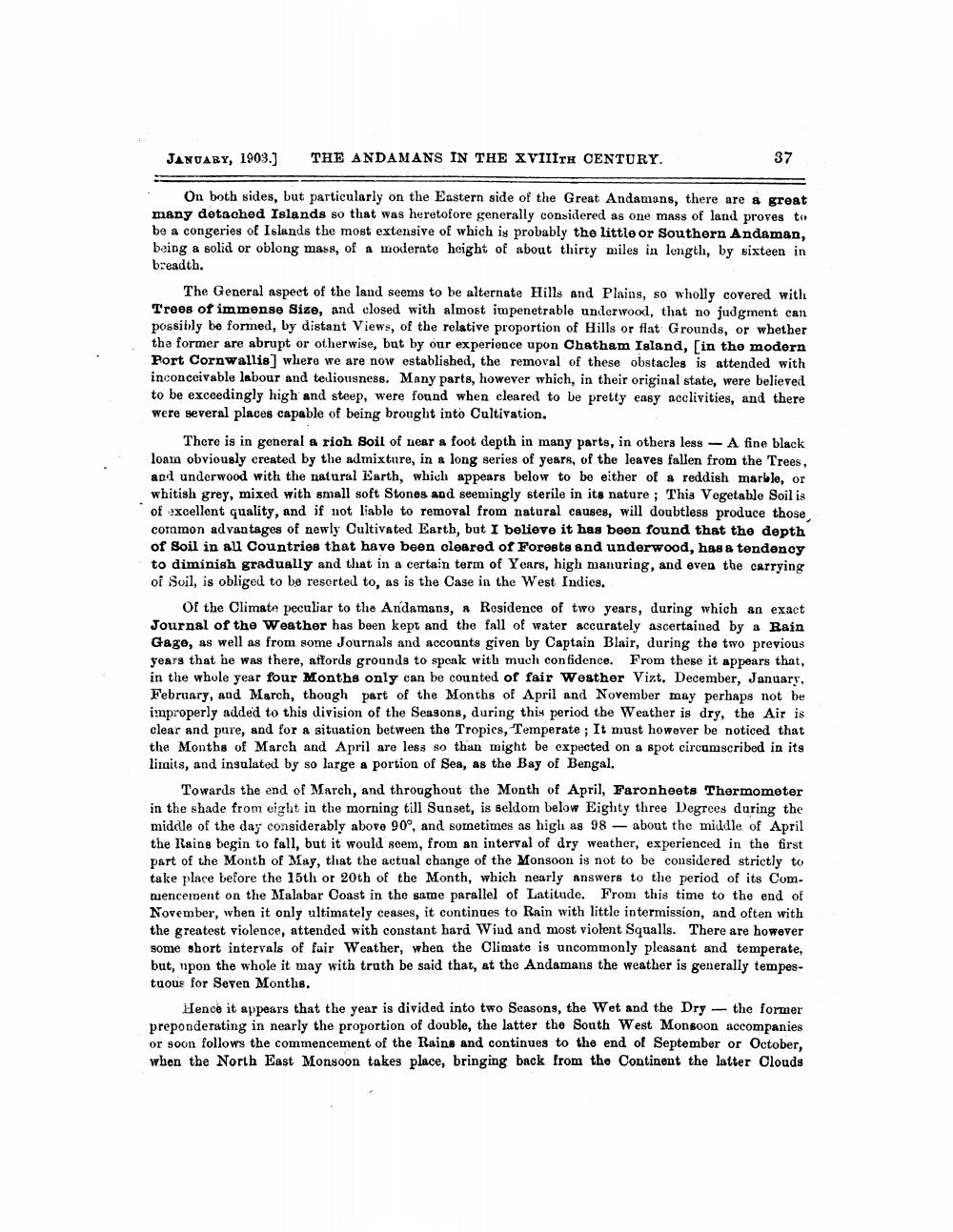________________
JANUARY, 1903.)
THE ANDAMANS IN THE XVIIITH CENTURY.
37
On both sides, but particularly on the Eastern side of the Great Andamans, there are a great many detached Islands so that was heretofore generally considered as one mass of land proves to be a congeries of Islands the most extensive of which is probably the little or Southern Andaman, being a solid or oblong mass, of a modernte height of about thirty miles in length, by sixteen in breadth.
The General aspect of the land seems to be alternate Hills and Plains, so wholly covered with Troes of immense Size, and closed with almost impenetrable underwood, that no judgment can possibly be formed, by distant Views, of the relative proportion of Hills or flat Grounds, or whether the former are abrupt or otherwise, but by our experience upon Chatham Island, [in the modern Port Cornwallis] where we are now established, the removal of these obstacles is attended with inconceivable labour and telliousness. Many parts, however which, in their original state, were believed to be exceedingly high and steep, were found when cleared to be pretty easy acclivities, and there were several places capable of being brought into Cultivation.
There is in general a rioh Soil of near a foot depth in many parts, in others less - A fine black loam obviously created by the admixture, in a long series of years, of the leaves fallen from the Trees, and underwood with the natural Earth, which appears below to be either of a reddish marble, or whitish grey, mixed with small soft Stones and seemingly sterile in its nature; This Vegetable Soil is of excellent quality, and if not liable to removal from natural causes, will doubtless produce those coramon advantages of newly Cultivated Earth, but I believe it has been found that the depth of Soil in all Countries that have been cleared of Forests and underwood, has a tendency to diminish gradually and that in a certain term of Years, high manuring, and even the carrying of Soil, is obliged to be resorted to, as is the Case in the West Indies.
Of the Climate peculiar to the Andamans, & Residence of two years, during which an exact Journal of the Weather has been kept and the fall of water accurately ascertained by a Rain Gage, as well as from some Journals and accounts given by Captain Blair, during the two previous years that he was there, affords grounds to speak with much confidence. From these it appears that, in the whole year four Months only can be counted of fair Weather Vizt. December, January, February, and March, though part of the Months of April and November may perhaps not be improperly added to this division of the Seasons, during this period the Weather is dry, the Air is clear and pure, and for a situation between the Tropics, Temperate ; It must however be noticed that the Months of March and April are less so than might be expected on a spot circumscribed in its limits, and insulated by so large a portion of Sea, as the Bay of Bengal.
Towards the end of March, and throughout the Month of April, Faronheets Thermometer in the shade from eight in the morning till Sunset, is seldom below Eighty three Degrees during the middle of the day considerably above 90°, and sometimes as high as 98 - about the middle of April the Rains begin to fall, but it would soem, from an interval of dry weather, experienced in the first part of the Month of May, that the actual change of the Monsoon is not to be considered strictly to take place before the 15th or 20th of the Month, which nearly answers to the period of its Com. mencement on the Malabar Coast in the same parallel of Latitude. From this time to the end of November, when it only ultimately ceases, it continues to Rain with little intermission, and often with the greatest violence, attended with constant hard Wind and most violent Squalls. There are however some short intervals of fair Weather, when the Climate is uncommonly pleasant and temperate, but, upon the whole it may with truth be said that, at the Andamans the weather is generally tempestuous for Seven Months.
Hence it appears that the year is divided into two Seasons, the Wet and the Dry - the former preponderating in nearly the proportion of double, the latter the South West Monsoon accompanies or soon follows the commencement of the Rains and continues to the end of September or October, when the North East Monsoon takes place, bringing back from the Continent the latter Clouds




